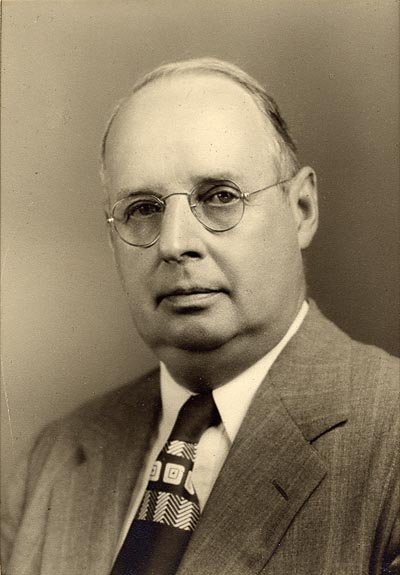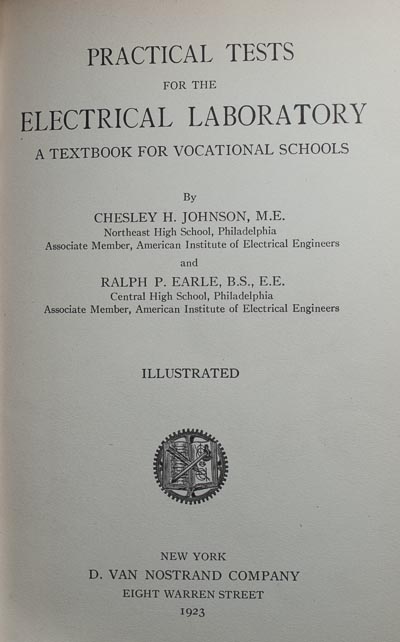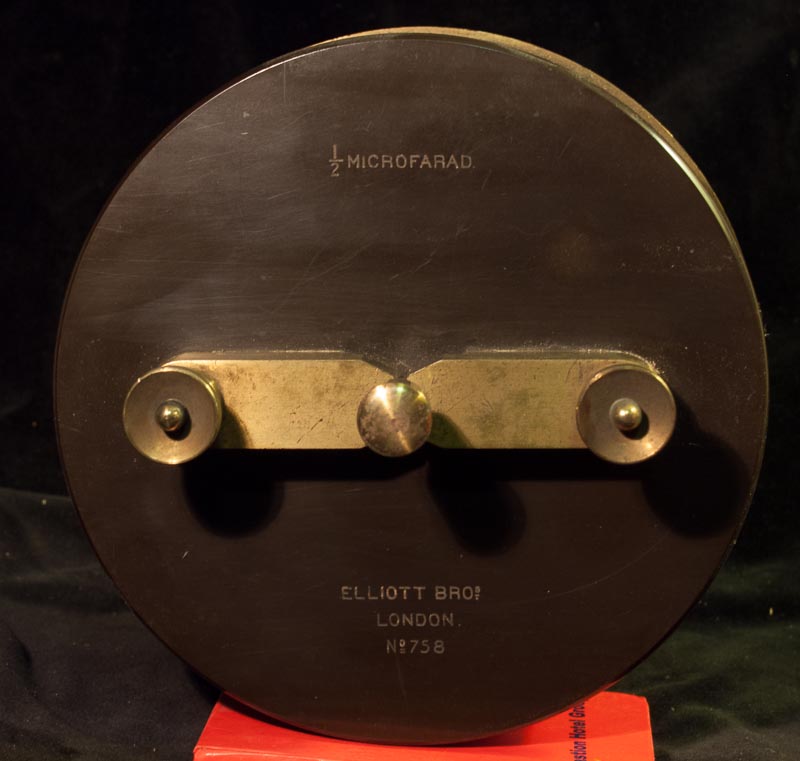Mysterious Antique Electrical Instruments | ||||
|
My grandfather invented electrical engineering. OK, I concede that may be a bit of an exaggeration. Family legends tend to grow in the telling. But, if he didn't invent it, he certainly got in on the ground floor; the basic units of electricity (volt, ohm, etc.) weren't standardized until 1893, about the time he was born. Here is my grandfather, Ralph Porter Earle, along with the book he coauthored in 1923, by which time he was a respected authority in the field:
Apart from this, I don't actually know much about my grandfather. I know he married before the U.S. entry to World War I, that he had a fling when in France (we still have her photo, a few interesting letters, and his medals), and that when he came home he became a teacher at a Philadelphia technical college, and that he died rather young, in his 50's. But I'm not posting this page to talk about my grandfather as such. I'm posting it because he left behind a number of intriguing electrical instruments that neither my father (a chemical engineer) nor I (an ecologist) have ever really understood the likely purpose or uses of. I'm hoping, by this strategem, to find someone who can shed some light on these devices. My email is listed at the bottom of this page. Let me know if you have some insights to offer, and I'll use that information to improve this page.
This one's easy. It's an ammeter. Grandfather bought the gauge and built the box himself. It still works pretty well; Dad used it as his standard ammeter, until he passed away. I have a matching voltmeter sitting around someplace.
This is the first mystery instrument. It's about 6 inches (15 cm) long. It is stamped "300 AMP" on one side and "100 MV." on the other side, and the top is stamped "T. May 16, 1893 No. 49742". I would think that's a patent number, because I've found that patents 497420 through 497429 were issued on that date; unfortunately none of them were for electrical devices.
This is the second mystery instrument. It's about 5 inches (12.5 cm) tall and 4 inches (10 cm) diameter. As with most of these instruments, it was made by the Elliott Bros. in London, a company that started in instruments back in 1804 and which went on develop some of the earliest electronic computers in the 1950s; later they were absorbed into General Electric. The black diamond-shaped piece is a key that can be placed in any of three holes to adjust the instrument's setting.
This fine Elliott Bros. instrument is a tangent galvanometer, which is a very sensitive type of ammeter that relies upon the earth's magnetic field and thus must be oriented before use. It stows away in a box measuring 21x11x9 inches (53x33x23 cm) and consists of four major subassemblies: a large brass instrument mounted on a tripod, having several fine adjustment screws; a standing wooden panel bearing a finely engraved measuring plate above a variable-width slit; a curved brass band; and an electric lamp. I don't know how all these pieces are to be placed relative to each other, though I suspect one looks through the cylinder at the measuring plate, behind which the light is mounted.
This what resides behind the glass plate covering one end of the brass cylinder.
This shows the brass plate covering the other end of the brass cylinder.
This shows the assembly of adjusting knobs on top of the brass cylinder.
This is the label inside the case, which apparently supplies calibration data, and contains the instructions "N.B. - Place the galvanometer East, and the Scale West, level it, take off the case and directing magnet, and raise carefully without turning, the milled-headed pin to which the astatic system is attached by a floss-silk fiber, until it swings freely. Should the image of the flame not be at Zero, turn the pin in the required direction, then replace the case and directing magnet, the marked end pointing North. With care it may be brought to about the middle of the rod, the image still remaining at Zero. By raising the magnet, the sensibility of the Instrument is decreased."
This is the third mystery instrument. The box is about 10 inches (25 cm) long.
It appears to be some sort of variable resistor; another Elliott Bros. product.
A view from above suggests that many different resistance values can be set by configuring the proper bridges.
This oblique view shows that the instrument is designed for "legal ohms". I don't know what the round hole is for - perhaps a standard plug of some sort could be inserted.
The closed box (about 8 inches or 20 cm long) suggests a mystery.
It contains another fine Elliott Bros. instrument...
Purchased in Philadelphia from James W. Queen & Co., which operated from 1870 until 1925, and evidently imported Elliott Bros. instruments. Perhaps all these instruments came from JW Queen - my father's family lived many generations in Philadelphia.
Inside the box is a 1/2 microfarad condenser. A modern 1/2 microfarad capacitor (assuming grandfather was working at about 100V) is smaller than a penny.
Oblique view of the capacitor.
|



















